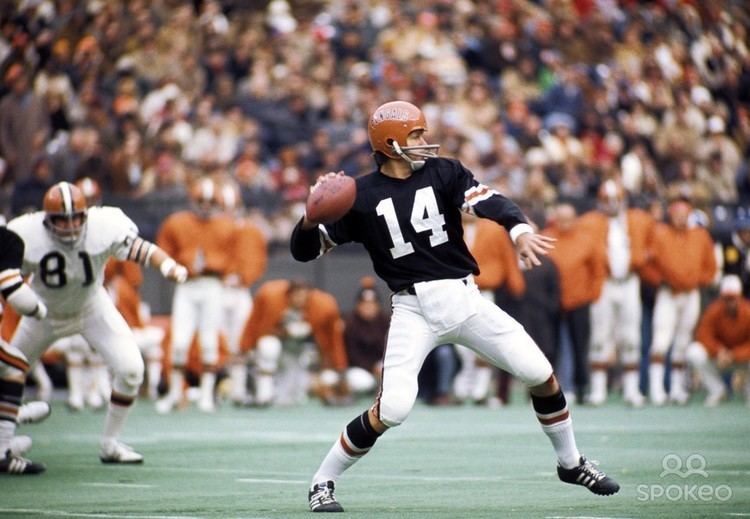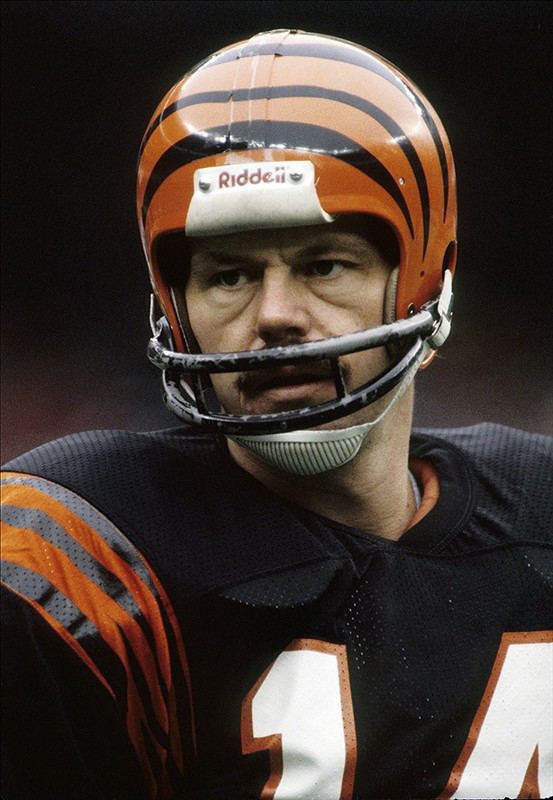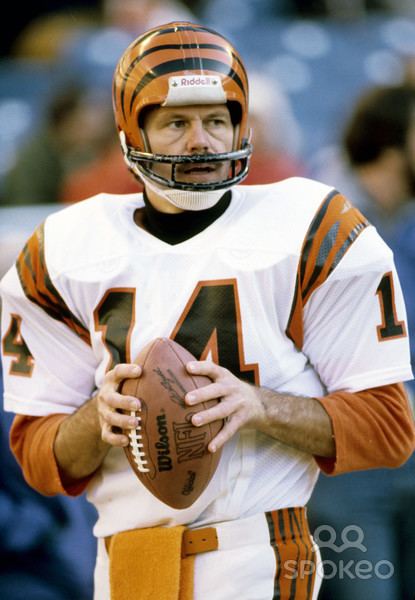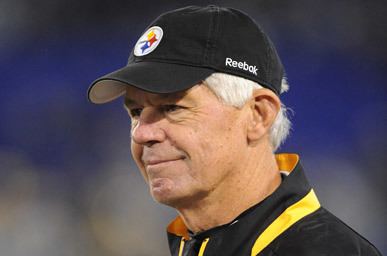Name Ken Anderson Height 1.88 m | Weight: 212 lb (96 kg) TD–INT: 197–160 Spouse Cristy Anderson | |
 | ||
Date of birth: (1949-02-15) February 15, 1949 (age 66) NFL draft: 1971 / Round: 3 / Pick: 67 Books Youth League Passing and Receiving, The Art of Quarterbacking, Nolan Ryan: Texas Fastball to Cooperstown Children Megan Anderson, Molly Anderson, Matt Anderson Similar People Bert Jones, Anthony Munoz, Dan Fouts, Boomer Esiason, Isaac Curtis | ||
Place of birth: Batavia, Illinois | ||
Ken anderson belongs in the pro football hall of fame by bob trumpy and dave lapham part 1 of 2
Kenneth Allan Anderson (born February 15, 1949) is a former American football quarterback who spent his entire professional career playing for the Cincinnati Bengals of the National Football League (NFL) and later returned as a position coach.
Contents
- Ken anderson belongs in the pro football hall of fame by bob trumpy and dave lapham part 1 of 2
- NFL
- Legacy
- Coaching career
- Personal life
- References

NFL

Anderson was born in Batavia, Illinois. After playing for and graduating from Augustana College (Illinois), he was drafted 67th overall in the 1971 NFL Draft by the Bengals and earned the starting quarterback job in 1972. He would become one of the most accurate short-range passers in the league, and was extremely effective at rushing the ball for a quarterback.

Because Bill Walsh was his quarterbacks coach, Anderson is considered to be one of the first quarterbacks to run what would become known as the "West Coast Offense." One of the finest performances of his early career was in a 1975 Monday Night Football game against the Buffalo Bills. In the game, Anderson passed for a franchise record 447 yards while the Bengals racked up a franchise record 553 offensive yards on their way to a 33-24 win. It was the Bengals' first ever win in a Monday night game.

Anderson's best season was in 1981, although it started out very badly for him. In the Bengals opening game against the Seattle Seahawks, Anderson was intercepted twice in the first half and the Seahawks built up a 21-10 halftime lead. In the second half, Cincinnati coach Forrest Gregg benched Anderson and brought in third-string quarterback Turk Schonert (second-string quarterback Jack Thompson was injured at the time). With Schonert in command of the offense, the Bengals stormed back and won the game 27-21. Gregg considered starting Schonert or Thompson for the next game against the New York Jets, but decided to stick with Anderson after an impassioned discussion the two had during the week leading up to the game. Anderson took advantage of his second chance by throwing for 246 yards and two touchdowns, and the Bengals won the game 31-30.

By the time the season ended, Anderson had completed 62.6% of his passes for 3,754 yards and 29 touchdowns, with only 10 interceptions, leading the NFL with a career-high 98.4 passer rating. He also gained another 320 yards and one touchdown on the ground. This performance earned him both the Associated Press and Professional Football Writers of America NFL Most Valuable Player Awards and the NFL Comeback Player of the Year Award. Anderson then led the Bengals to their first ever playoff victory over the Buffalo Bills, as he led Cincinnati to a 27-7 win in the AFC championship game (which later became known as the Freezer Bowl) over the San Diego Chargers, earning a trip to the first Super Bowl appearance in franchise history.

The Bengals lost Super Bowl XVI 26-21 to the San Francisco 49ers, but Anderson had a solid performance, especially in the second half, despite his team trailing 20-0 at the end of the first half. He completed 25 of 34 passes for 300 yards and two touchdowns, with two interceptions, and gained 14 rushing yards and a touchdown on five rushing attempts. At the time, his 25 completions and 73.5% completion percentage were both Super Bowl records.
The following season (1982), Anderson set an NFL record by completing 70.6% of his passes, but his team lost in the first round of the playoffs at Riverfront Stadium to the New York Jets. Anderson continued as the Bengals starting quarterback for the next two seasons, but in both seasons he threw more interceptions than touchdowns, was injured for stretches, and the Bengals failed to make the playoffs. In 1985, he was replaced by Boomer Esiason for the third game of the season, a home contest against the Chargers. From this point on, Anderson backed up Esiason before retiring after the 1986 season.
In his 16 NFL seasons, Anderson completed 2,654 of 4,475 passes (59.3%) for 32,838 yards and 197 touchdowns and 160 interceptions. He also gained 2,220 rushing yards and 20 touchdowns on 397 carries. His completions, passing yards, and touchdown passes are all Bengals records. His 2,220 rushing yards are the most ever by a Bengals quarterback. Anderson led the NFL in quarterback rating four times during his career (1974, '75, '81 and '82) and led the league in passing yards twice (1974, 1975). He was selected to four Pro Bowls (1975-76 & 1981-82). Anderson was voted All-Pro in 1981, 2nd Team All-Pro in 1975 and 2nd Team All-AFC in 1974 & 1982.
Although not officially retired by the Bengals, Anderson's number 14 had been held in reserve and not assigned to any player by the team until Anderson started coaching for division rival Pittsburgh Steelers. The holding of number 14 was most evident in 1998, when the Bengals signed Neil O'Donnell, who wore number 14 during most of his career. O'Donnell wore number 12 during his one-year stay in Cincinnati, the only time in his NFL career he did not wear number 14. With Anderson's approval, Andy Dalton has worn number 14 for the Bengals since being drafted in 2011.
Legacy
At the time of Anderson's retirement following the 1986 season, he held NFL records for consecutive pass completions (20), completion percentage for a single game (20 of 22, 90.9%, vs. Pittsburgh in 1974) and completion percentage for a season (70.6% in 1982), as well as the Super Bowl records for completion percentage (73.5%) (since broken by Phil Simms) and completions (25; Tom Brady holds the current record with 37). While Anderson's record for regular season completion percentage happened in a strike-shortened 9-game season, the previous record he surpassed had been set by Sammy Baugh in a 10-game season (1945), in which Baugh threw 125 less passes then Anderson did in 1982. Furthermore, Anderson was ranked 6th all-time for passing yards in a career at the time of his retirement. Anderson's record for completion percentage in a season stood for 27 years after his retirement (broken by Drew Brees in 2009). As of 2005, he is among the top 30 all-time leaders in pass attempts (24th), completions (18th), passing yards (21st) and passing touchdowns (28th). He led the NFL in passing yards and completions twice, and lead the league in fewest interceptions per pass attempt 3 times. He ranks seventh in NFL history for postseason quarterback rating, 93.5.
He has been nominated for the Pro Football Hall of Fame several times, and on two occasions was among the 15 finalists for enshrinement (1996 and 1998). In 2011, the Professional Football Researchers Association named Anderson to the PFRA Hall of Very Good Class of 2011
In 2008, NFL Network selected Anderson as No. 10 on their list of top 10 players who had not been inducted into the Pro Football Hall of Fame.
As of 2017's NFL off-season, Ken Anderson held at least 31 Bengals franchise records, including:
Coaching career
After serving as a color analyst for the Bengals' radio broadcasts from 1987–1992, Anderson re-joined the team in 1993 as their quarterbacks coach, a position he held until 1996. He then served as the team's offensive coordinator from 1996–2000, and again as the team's quarterbacks coach in 2001 and 2002. In 2003, he became a wide receivers coach for the Jacksonville Jaguars, and was their quarterbacks coach. He was fired after the 2006 season, along with offensive coordinator Carl Smith and special teams coach Pete Rodriguez, by Jack Del Rio. In January 2007, new Steelers head coach Mike Tomlin hired Anderson as his quarterbacks coach under offensive coordinator Bruce Arians. On January 5, 2010, Tomlin announced that Anderson would be retiring, effective immediately. Anderson earned a Super Bowl ring when the Steelers won Super Bowl XLIII.
Personal life
Anderson and his wife Cristy live in Pittsburgh. The couple have three children: Matt, Megan, and Molly. Anderson attended Salmon P. Chase College of Law at Northern Kentucky University and received a law degree.
